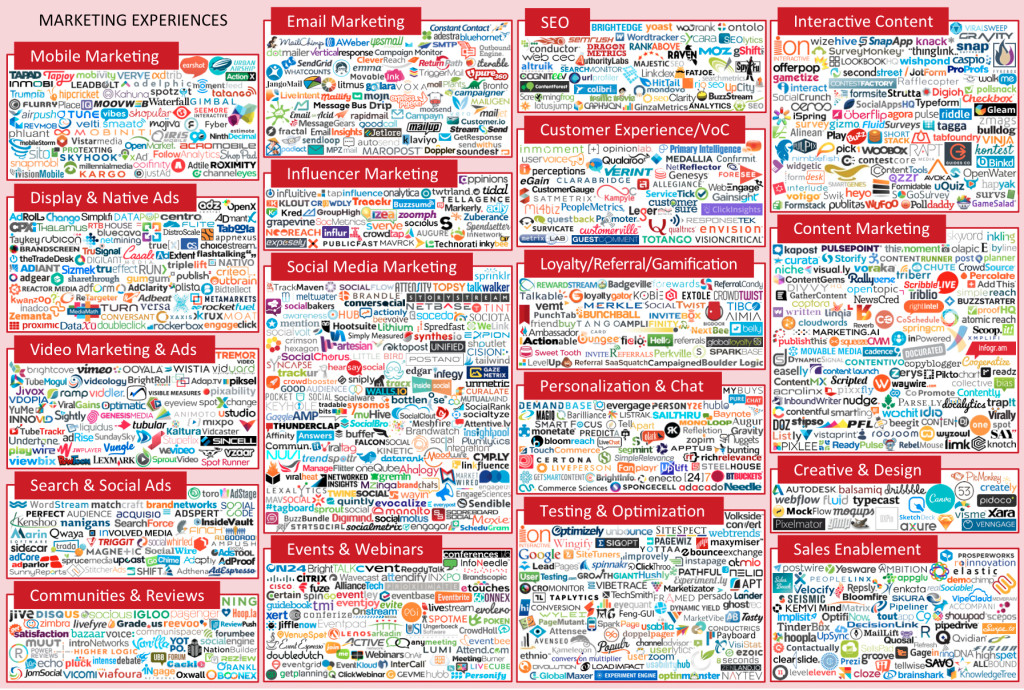In my first round of analysis on the MarTech Supergraphic I mentioned that looking at this infographic is a bit like viewing a Monet: You have to take a step back in order to see the full picture. When you do this, one thing that jumps out immediately is that the Marketing Experiences category is huge.

I immediately wanted to know why. What are these marketing software companies and why are there so many of them? To get some answers, I had to zoom in and study the companies themselves (with a little help with my friends at Mechanical Turk). A few things quickly became clear:
- These companies are responsible for touching customers: actually serving up marketing experiences.
- Most of these companies focus on the delivery of media through a single channel or type of experience. Many are building entire companies around point solutions, in stark contrast to the more horizontal solutions offered in other categories in the infographic.
- The space is growing fast: In 2012, 120 Marketing Experiences companies were founded, as opposed to just 69 new companies across all other categories combined.
So here’s the billion-dollar question: If there are more Marketing Experiences companies because each of them is more narrowly focused, is the average company worth less? My guess is yes, and the data backs it up:
- The mean amount of funding received by Marketing Experiences companies is $25 million; the lowest among any category in the infographic.
- On average, marketing experiences companies employ half the number of people of other martech companies in the infographic.
Read on for the full results:
What marketing technology categories are drawing the most investment dollars?
Marketing Experiences companies are raising the fewest dollars on a per-company basis. While this isn’t an open-and-shut case, it’s pretty strong evidence in support of my hypothesis. Investment dollars are correlated to valuations, and marketing experiences companies are raising less than the other categories. And looking at these numbers on a median basis doesn’t change the story much:
What categories are employing the most people?
One of the problems with equating funding with value is that it might just require less capital to build a marketing experiences company. As anyone who has ever run a startup can tell you, the biggest expense is nearly always headcount. I decided to take a look at employee counts across each category.
On average, a Marketing Experiences company is employing fewer than half the number of people of companies in other categories. While this does not conclusively tell us that these companies are less lucrative, headcount and funding are both commonly accepted indicators of high growth. It’s noteworthy that the companies in this category fall short on both dimensions relative to their peers in other categories.
What categories have the most new market entrants?
Judging by what we’ve seen so far, Marketing Experiences companies are consuming less capital and headcount to get off the ground. This lowers two common barriers to building a business, and may be responsible for the huge growth in the absolute number of Marketing Experiences companies created in the past decade.
While every category has seen growth over the last 5-10 years, Marketing Experiences companies have left the other categories in the dust. In 2012, 120 Marketing Experiences companies were founded. Across all other categories, only 69 companies were founded.
In the past decade, as advertising dollars have shifted to digital advertising and the number of digital channels has grown, it’s no surprise that Marketing Experiences companies have grown as well. (Note that the data in recent years skews downwards only because it takes time for a newly founded company to make its way into the supergraphic.)
What does this say about the future?
We’ve learned that there are more Marketing Experiences companies, that they’re being founded at a greater rate, that they receive less funding, and have fewer employees. This is indicative of a space in its formative years and an efficient market exploring every new avenue for innovation.
This type of cambrian explosion is often followed by a period of consolidation as the more successful companies outcompete their weaker rivals and as established companies buy up new entrants to expand their capabilities. That’s not necessarily a bad thing—there will be plenty of happy founders coming out of this process. But we’re far from a stable state of maturity in this category.
In the meantime, the market is putting a speed limit on new company formation: it’s becoming harder to raise an A round. The latest headline from Mattermark warns that “Founder competition for Series A deals is fierce, due to record number of seed-funded startups in the funnel.” In 2014 the graduation rate from Seed to Series A was at 15%, in 2015, that number has dropped to just over 5%.
I have no doubt that some enormous companies will emerge from this segment. As of this moment, however, separating the signal from the noise is a job for the professional VCs—and it appears they’re placing the bar higher than ever.
